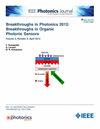Performance Evaluation of Dual-Drive Mach-Zehnder Modulator and Optomechanical Crystal Cavity Comb Generation for All-Optical Band Conversion in 5G-Advanced Cellular Systems
IF 2.4
4区 工程技术
Q3 ENGINEERING, ELECTRICAL & ELECTRONIC
引用次数: 0
Abstract
Multiband operation is a key aspect of emerging 5G-Advanced cellular systems, also named 5.5G, which target seamless provision of multi-gigabit per second connectivity employing sub-6 GHz and mm-wave overlapping coverage. All-optical frequency conversion gives flexibility due to the feasible high-speed reconfiguration in broad bands and large radio signal bandwidth. Optical frequency combs, featuring a spectrum of discrete, equally spaced coherent frequency lines, are crucial for high-precision metrology, spectroscopy, and telecommunications. Their effectiveness in all-optical frequency conversion depends on their stability in terms of frequency drift, phase noise, and power distribution across the comb lines. This paper evaluates experimentally the generation of optical frequency combs employing two distinct technologies: a dual-driven Mach-Zehnder modulator (DD-MZM) and an optomechanical crystal cavity (OMCC), and experimentally compares their performance for all-optical frequency conversion of 5G data streams. The DD-MZM implementation generates a comb with flexible line spacing and comprising several spectrum-flat lines with low phase noise (5g先进蜂窝系统全光波段转换双驱动Mach-Zehnder调制器和光机械晶体腔梳生成性能评估
多频段操作是新兴5g先进蜂窝系统(也称为5.5G)的一个关键方面,该系统旨在利用低于6 GHz和毫米波的重叠覆盖,无缝提供每秒千兆位的连接。全光频率转换由于在宽频带和大无线电信号带宽范围内的高速重构而具有灵活性。光学频率梳具有离散的、等间隔的相干频率线的频谱,在高精度计量、光谱学和电信中至关重要。它们在全光频率转换中的有效性取决于它们在频率漂移、相位噪声和梳线功率分布方面的稳定性。本文实验评估了采用双驱动马赫-曾德尔调制器(DD-MZM)和光机械晶体腔(OMCC)两种不同技术的光频率梳的产生,并实验比较了它们在5G数据流全光频率转换中的性能。DD-MZM实现产生具有灵活线间距的梳状结构,由几条具有低相位噪声的频谱平坦线组成(1 kHz偏移时为$-88.5$ dBc/Hz, 100 kHz偏移时为$-108.3$ dBc/Hz)。OMCC实现提供了更小的占地面积(182 $\mu \ mathm {m}^{2}$),因为它是在硅芯片上实现的,并且具有在没有外部本地振荡器的情况下产生光梳的额外优势,这降低了其功率要求(低于1 mW),同时提供了相位噪声$-38.3$ dBc/Hz在1 kHz偏移和$-97.1$ dBc/Hz在100 kHz偏移。对两种实现的极化稳定性和抖动进行了评价。实验演示评估了两种实现的3GPP 5G NR频率转换信号的误差矢量幅值(EVM),证实了DD-MZM在三次谐波下的EVM小于12.01%,OMCC一次谐波下的EVM小于17.36%。
本文章由计算机程序翻译,如有差异,请以英文原文为准。
求助全文
约1分钟内获得全文
求助全文
来源期刊

IEEE Photonics Journal
ENGINEERING, ELECTRICAL & ELECTRONIC-OPTICS
CiteScore
4.50
自引率
8.30%
发文量
489
审稿时长
1.4 months
期刊介绍:
Breakthroughs in the generation of light and in its control and utilization have given rise to the field of Photonics, a rapidly expanding area of science and technology with major technological and economic impact. Photonics integrates quantum electronics and optics to accelerate progress in the generation of novel photon sources and in their utilization in emerging applications at the micro and nano scales spanning from the far-infrared/THz to the x-ray region of the electromagnetic spectrum. IEEE Photonics Journal is an online-only journal dedicated to the rapid disclosure of top-quality peer-reviewed research at the forefront of all areas of photonics. Contributions addressing issues ranging from fundamental understanding to emerging technologies and applications are within the scope of the Journal. The Journal includes topics in: Photon sources from far infrared to X-rays, Photonics materials and engineered photonic structures, Integrated optics and optoelectronic, Ultrafast, attosecond, high field and short wavelength photonics, Biophotonics, including DNA photonics, Nanophotonics, Magnetophotonics, Fundamentals of light propagation and interaction; nonlinear effects, Optical data storage, Fiber optics and optical communications devices, systems, and technologies, Micro Opto Electro Mechanical Systems (MOEMS), Microwave photonics, Optical Sensors.
 求助内容:
求助内容: 应助结果提醒方式:
应助结果提醒方式:


